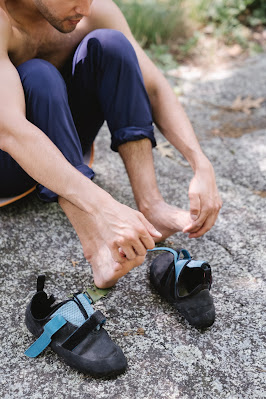Having Plantar Fasciitis? Here Is How To Treat It Effectively!!
Plantar Fasciitis
 |
| Foot Pain: Plantar Fasciitis |
Causes And Predisposing Factors
The function of the plantar fascia is to absorb pressure and support arch of the foot while standing, running or working. Any activity or condition which causes repetitive overuse or over stretching of the fascia may cause plantar fasciitis. Here are few causes and predisposing factors associated with plantar fascia:
- Age: It is commonly seen in people from aged 40 to 60
- Activities: Certain activities which cause high impact on foot may cause inflammation of plantar fascia. For example: running, dancing, vigorous exercise.
- Anatomical: People with flat foot or high arch are more prone to develop plantar fasciitis.
- Obesity: More weight, more pressure on feet. Increased pressure on feet cause wear and tear of plantar fascia. Therefore, obese and pregnant ladies may suffer from plantar fasciitis.
- Occupation: Professions which require prolonged standing may expose individuals to develop plantar fasciitis. For example: workers, teachers and nurses.
- Other Causes: Tightness of gastrocnemius, soleus, and/or other posterior leg muscles, excessive use of high heels, faulty or damaged shoes.
Symptoms
- Pain is the major symptom seen in plantar fasciitis. It is localised to inferior and medial heel. However, it may radiate proximally in severe cases.
- It can be sharp/stabbing/dull pain. It is worst in the morning when a person is out of bed and takes few steps.
- The pain is felt at the bottom of the foot ranging from heel to mid of the foot. It increases with the activities.
- People find it difficult to climb stairs.
Diagnosis
Foot is a complex human structure which involves large number of bones, ligaments and muscle. A history of overuse with faulty arch of foot may indicate plantar fasciitis however, imaging studies such as x-rays, ultrasound and MRI are done to find out thickening or swelling of the fascia or any other cause of injury like stress fracture or heel spur.
Management
Nonsurgical Treatment For Plantar Fasciitis
- Rest: This is the first step to help the person with plantar fasciitis. Take rest when its paining. Stop doing any activity like running, dancing or walking and standing for long duration. It decreases the pain sensation and further injury to plantar fascia.
- Reducing Pain: Ice is a good option to start with. 15-20 minutes of application of ice to the affected area can reduce inflammation and swelling which is the main cause of the pain.
- Modification: Modify the activity to reduce repetitive injury to plantar fascia. Patient should be advised to perform non-weight bearing activities like cycling instead of walking or running. Avoid wearing faulty footwears.
- Medications: Ibuprofen or other Nonsteroidal anti-inflammatory drugs (NSAIDs) may decrease pain sensation.
Massage: It is reported that deep friction massage of the arch helps in plantar fasciitis. In addition, cross friction massage or transverse massage is shown to be helpful by reducing inflammation and breaking the adhesions. This provides soothing effects and increase flexibility of the plantar fascia.
Massage
- Physical therapy: Physical therapy plays an important role in treatment of plantar fasciitis. The therapy includes:
- Stretching of plantar fascia and calf muscle or Achilles tendons to relieve the stress
- Exercises to strengthen muscles of the lower limb and intrinsic muscles of the foot
- Splints and Braces: Night splints to stretch calf muscle and the arch of foot are useful to prevent feeling of pain and stiffness in the morning. Flat foot and loss of arch is one of the causes of plantar fasciitis. Therefore, arch supports can help in distributing pressure and prevent injury to the plantar fascia. Arch supports or inserts are usually fixed to shoes and foot wears.
- Shock wave therapy: Extracorporeal shock wave therapy is another nonsurgical treatment option to treat plantar fasciitis. The shock waves stimulate healing of the ligament and fascia. Many studies shows that the outcome of shock wave therapy depends on machine type (electrohydraulic, electromagnetic, and piezoelectric systems) and treatment protocols. However, bone marrow edema, osteonecrosis, and tendon ruptures, bruises, swelling, pain and numbness are some side effects of this treatment. These are but may be seen in high energy shock wave therapy.
Surgical Treatment For Plantar Fasciitis
Surgery is considered if pain is severe or lasts more than 6 to 12 months. Surgery should be approached if treatment options have failed. There are two types of surgeries that help in plantar fasciitis.
Conclusion
Plantar fasciitis is one of the reasons of foot pain. It sometimes may be confused with heel pain due to heel spur. Repetitive micro trauma, obesity and faulty foot wear increase the risk of plantar fascia. Hence, one should start with slow movements and gradually increase the intensity of the activity.
Strategies to reduce the weight should be adopted if the person is overweight. Studies show that 75% cases resolve with in 12 months and only 5% need surgery. Surgery should be the last option as results are not satisfactory.
You May Also Like:




Very informative post. Thank you for including suggestive management too. Great read.🤗
ReplyDeletePastor Natalie (ExamineThisMoment)
Letstakeamoment.com
Interesting, I didn't even know about this problem. The worst pain I've ever had in my foot was on the bridge of my foot because I tried to sweep my sensei in karate class.
ReplyDeleteI've had this issue since a young age (24), I appreciate your suggestions on how to help deal with it.
ReplyDeleteThis is such a painful condition! I've never had it myself but have known many who have and it is awful to watch them suffer. While the treatment can be very effective it often doesn't mean that it's gone forever.
ReplyDelete